Maintaining Hot Food Temperature While Transporting Meals
EXECUTIVE SUMMARY
Serving hot meals can be a challenge if the meal is served in the housing unit. Serving hot food in a dining facility is straight forward: hot kettle or tilt skillet to heated hot box to heated steam table, then dish it up and hand it over nice and hot. But what if you dish it up and hand it over 45 minutes later? Maybe not so nice and hot now.
What are the key variables that help keep the food hot the longest? What type of food tray and what type of delivery carts can help keep the food hot? We conducted a temperature study to answer those questions. The purpose of this white paper is to interpret the results of that study and offer suggestions for you to better serve hotter meals in housing units. If you aren’t looking for the detail and background of the temperature study but only want to know what is recommended, just skip to the bottom of this article.
THE IMPORTANCE OF HOT FOOD
SAFETY
It is critical to get certain foods up to certain temperatures in order to kill pathogens. Anybody in the food service industry has been trained over and over on what these details are. This paper is not getting into this aspect of hot food. For the purposes of this study, it is assumed that the correct food temperature was reached in the food preparation process. However, after it has been cooked, how hot must the food be kept in order to stay safe? How long will it stay safe? These are key questions to answer when dealing with meals being delivered to the housing units.
After the pathogens are killed in the food preparation process, it takes several hours for pathogens to be reintroduced into the food and grow to a dangerous level. Most standards and guidelines allow 2 hours for hot food to stay out in ambient temperatures before it is too late to serve it safely, some allow 4 hours. Except for extreme circumstances, hot food delivery to the housing units is not really a matter of food safety.
Satisfaction
This is more of what this issue is all about. Have you ever put a spoonful of soup in your mouth only to be surprised that it is lukewarm or cold? You want to spit it back out. If you get everything else right- great recipe, fresh quality ingredients, perfect preparation, it is all for nothing if hot food is served cold. Food that is supposed to be hot but isn’t is very dissatisfying. I was told by a seasoned vet in the corrections industry, “You will see unrest (possibly dangerous unrest) if you mess up on either of two things; mail and food. Don’t ever get those wrong in corrections or you’ll end up paying for it.” There are plenty of articles and reports to back up the connection between food problems and inmate unrest, including full-scale riots.
When we take up the mission to make sure hot food is served hot in the housing units, we are addressing an important safety issue but it’s not food safety. Preventing potential inmate unrest is critical. In a less dramatic tone, serving satisfactory meals improves the morale and temperament of the inmate population, reduces the administrative burden of responding to complaints and lawsuits, and reduces food waste. And in the end, we all take pride in our work and want to do a good job of what we are charged to do.
What is considered a satisfactory temperature for hot food is, of course, subjective. Different people hold different opinions on how hot is hot enough, and different foods have their own desirable “hot” temperatures as well. For instance, soup might not be considered hot enough unless it was at least 150°F, but a hamburger would be probably considered still “hot” if it was 140°F. The general guidance of chefs is for hot food to be served between 140°F and 150°F and anything below 125°F is too cold to serve. For the sake of this study, we will consider anything below 120°F to be unsatisfactory. Each chart will have a red dotted line at that temperature level for comparison.
TEMPERATURE STUDY
In this paper, we analyze the temperature loss over time and compare various combinations of trays and carts. For each trial, we will review the data and draw conclusions. In addition, we’ll analyze key variables in the tray make up process and their effect on the ability to serve hot food. Finally, this paper will summarize key considerations in serving hot food for meals delivered to housing units.
Methodology
Each of the 5 study trials followed the same methodology.
- Two food types were used in each trial; diced tomato in tomato juice and tomato sauce. The temperature results of the two are averaged to get one value.
- Every trial combination was tested twice, and the two results were averaged to get one value. This is the value that is charted and analyzed.
- Digital thermometers with wired probe were calibrated, had new batteries and were used on same food items through all trials.
- Bulk food pans with the food items were brought slowly up to temperature over 4 hours to have consistent temperature throughout the whole sample.
- Starting food temps in this study were targeted for 150°F +/-. Most hot food is higher than that in the kettle or skillet, but then it cools down as it goes to bulk food holding, and then to steam table, and finally onto the tray.
- 10 ounces of each food item where dished into two separate compartments. The same compartments for the same food items were used in every tray.
- Food temperatures were recorded at consistent intervals after tray make up: 5min, 20min, 30min, 45min, 60min to determine temperature loss over time.
- For each time iteration, the tray second from the top was taken out, door reclosed, and the temperature taken and recorded of the two food items in that tray.
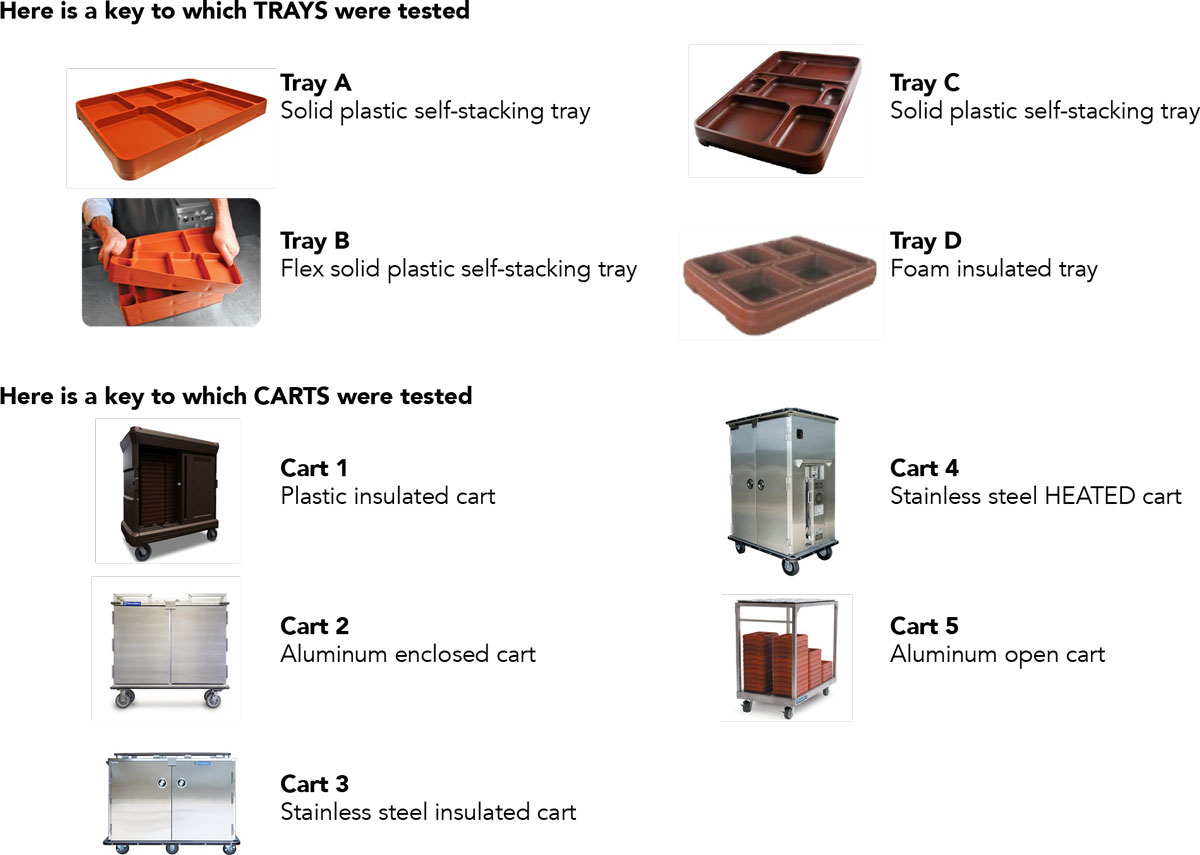
1. TRAY TEST IN INSULATED CART
SUMMARY
ALL NON-INSULATED TRAYS HOLD HEAT ABOUT THE SAME AND NEED TO BE SERVED IN 20-30 MINUTES WHEN DELIVERED IN NON-HEATED CARTS. INSULATED TRAYS HAVE 45-50 MINUTES.
There is a significant variety of meal trays used in corrections. This trial compares trays that stack on one another – self-stacking trays. Some self-stacking trays are filled with foam insulation (insulated trays) and some are solid plastic (Marathon, SmartTray, Stacker, etc.). Three solid plastic self-stacking trays (A, B and C) and one insulated tray (D) were tested in this trial. All were tested in the same cart (Cart 3) to compare results of the tray performance only.
Hot food items were portioned into the same two compartments for each tray and an initial temperature was recorded. The trays were stacked 7 trays high and placed in the food cart and closed the door. The 5 trays in the center of those 7 trays were used to take the temperature measurements.
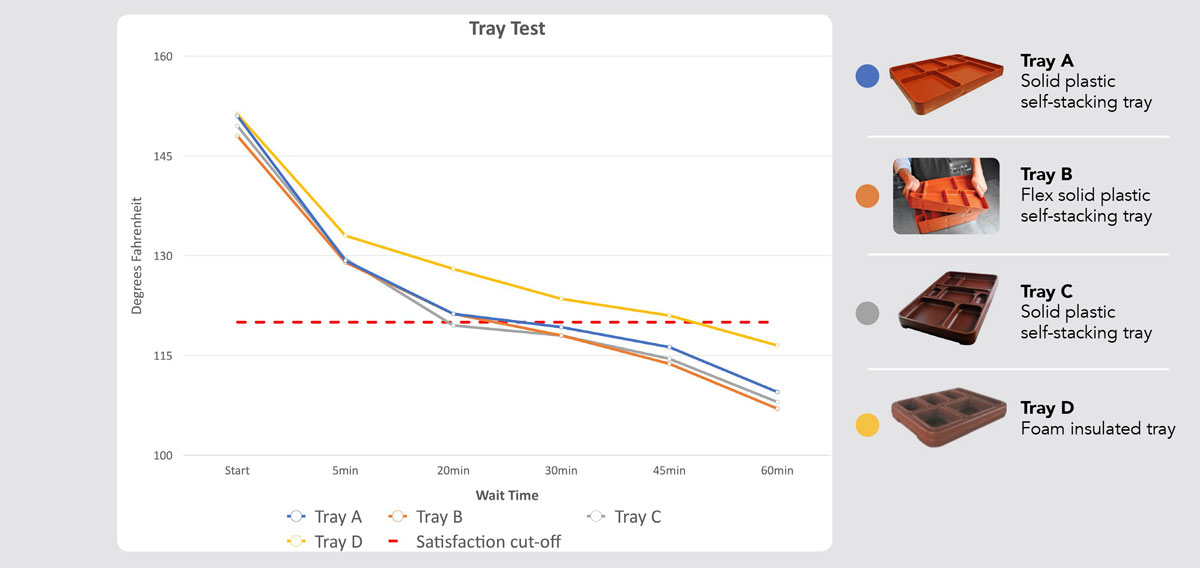
CONCLUSIONS
- The initial 5 minutes have the most significant temperature loss. The food temperature drops around 13% (~20°F) within only 5 minutes of being dished into the tray. Why? As hot food hits the cooler temperature of the plastic tray surface, the two temperatures seek to normalize and that pulls heat out of the food and into the tray.
- The next most significant heat loss for non-insulated trays is between 5 minutes and 20 minutes. Once the food and tray are about the same temperature, then the cooler temperature around the stack of trays inside the cart seeks to normalize and further pulls heat out of the stack of trays.
- Once the stack of food trays and the inside of the cart ar e about the same temperature (20 minutes), then the food temperature becomes more stable and the temperature loss slows down.
- All of the solid plastic self-stacking trays perform about the same. Even one tray that the manufacturer says is made “out of an insulating material” is really no different. Unless you can deliver the meal within 20-30 minutes of traying it up on the kitchen, it will likely be below the threshold for “hot food” when the first bite is taken.
- The insulated tray clearly performs differently. It has the same effect of hot food normalizing with the cooler tray surface in the first 5 minutes but after that, it has a better ability to resist the heat moving from the stack of trays to the inside of the cart. After the first 5 minutes, the temperature loss is somewhat linear. You have a good chance of serving what can be considered hot food if you can deliver it within 45 to 50 minutes of tray make up.
2. CART TEST WITH NON-INSULATED TRAY
SUMMARY
IF USING NON-INSULATED TRAYS, YOU SHOULD USE HEATED CARTS TO DELIVER MEALS UNLESS YOU CAN RELIABLY DELIVER THE MEAL IN 20-30 MINUTES.
Though not as numerous as tray options, there are still quite a few variations of meal delivery carts out there. In this study, we compared the temperature retention performance of an insulated plastic cart (1), an enclosed aluminum cart (2), an insulated stainless-steel cart (3), a heated stainless-steel cart (4), and a basic open utility cart (5).
The same tray type was used for all cart trials (Tray A) so that we are only comparing the performance of the carts. Hot food items were portioned into the same two compartments for each tray and an initial temperature was recorded. The trays were stacked 7 trays high and placed in the cart (on top of the cart for the open utility cart). The 5 trays in the center of those 7 trays were used to take the temperature measurements.
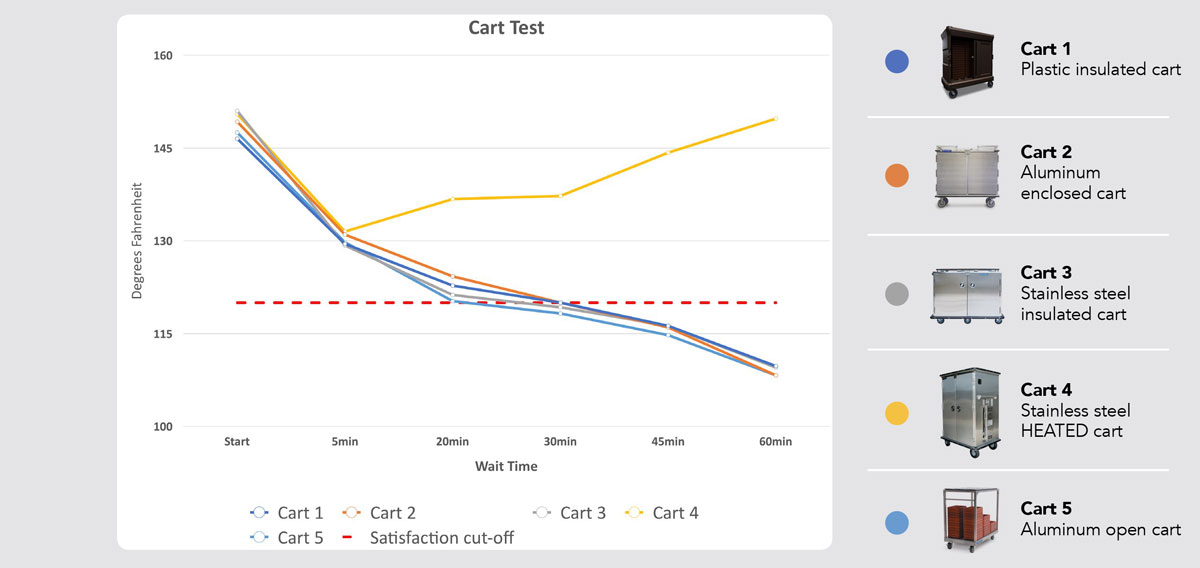
CONCLUSIONS
- Again, this cart analysis is with non-insulated trays that are solid plastic (A)
- The same phenomenon is true with the initial 5-minute temp loss as with the tray test in section 1, regardless of cart.
- For all except for the heated cart, the performance for temperature maintenance is virtually the same. Based on this result, you would not choose a cart to buy/use based on its ability to hold food temperatures. They’re all basically the same, whether insulated or not, plastic, steel, open, whatever. You would base your decision on other factors such as cost, durability, cleanability, ability to secure the food from tamper/theft, prevent contraband, ease of use, etc.
- Using a non-insulated tray combined with a non-heated cart, you need the ability to deliver and serve the meal within 20 to 30 minutes or it will likely be below the threshold for “hot food” when the first bite is taken.
- After the initial 5 minute “shock”, the HEATED cart (D) begins to warm the food back up. It will return to the initial food temperature and beyond, depending on the set temperature of the thermostat. (see yellow line in chart above)
- Unless you can deliver and serve the meal in 20 to 30 minutes from tray up in the kitchen to first bite, the most assured way to serve hot food above the 120°F threshold is to use heated carts when using non-insulated trays.
3. CART TEST WITH INSULATED TRAY
SUMMARY
IF USING INSULATED TRAYS, YOU HAVE 45-50 MINUTES TO DELIVER THE MEAL WITH ANY TYPE OF NON-HEATED CART. YOU HAVE AN INDEFINITE AMOUNT OF TIME USING A HEATED CART.
The same carts were tested as in section 2. (an insulated plastic cart, an enclosed aluminum cart, an insulated stainless-steel cart, a heated stainless-steel cart, and a basic open utility cart)
This time a foam insulated tray (D) was used for all tests instead of a solid plastic tray (A). Hot food items were portioned into the same two compartments for each tray and an initial temperature was recorded. The trays were stacked 7 trays high and placed in the cart (on the cart for the open utility cart). The 5 trays in the center of those 7 trays were used to take the temperature measurements.
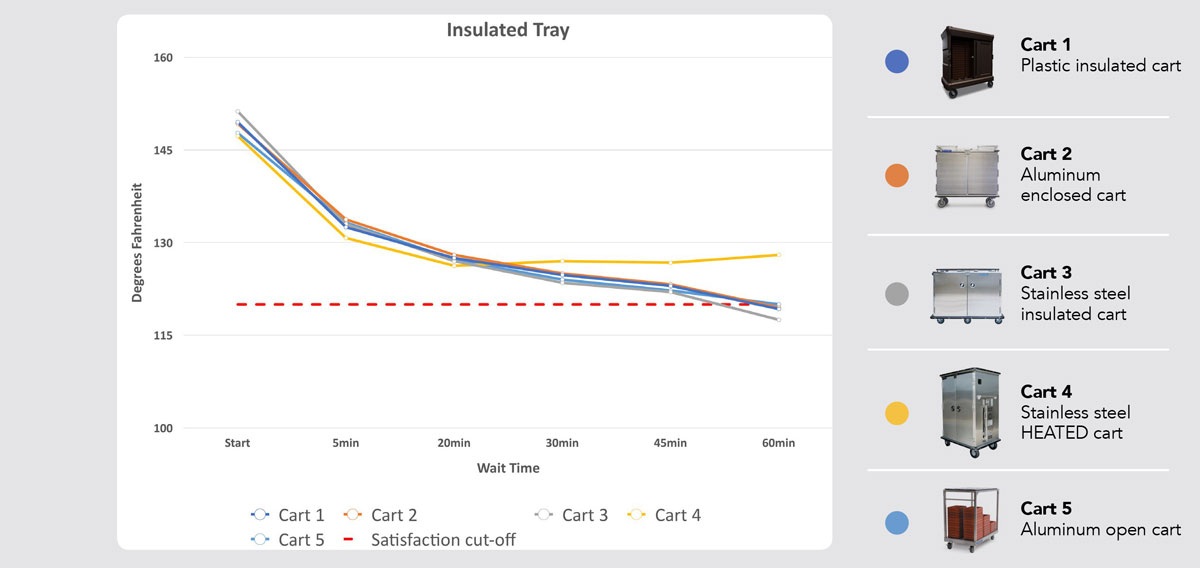
CONCLUSIONS
- Again, this cart trial is with foam insulated trays (Tray D)
- The same phenomenon is true with the initial 5-minute temp loss regardless of cart or tray.
- For non-heated carts, the performance for temperature maintenance is virtually the same and mirrors the results from section 1 for the insulated tray (D) (see yellow line in chart on page 3). Based on this result, you would not choose a cart to buy/use based on its ability to hold food temperatures. You would base your decision on other factors such as cost, durability, cleanability, ability to secure the food from tamper/theft, prevent contraband, ease of use, etc. Most facilities that use insulated trays deliver them with inexpensive open carts because you don’t hold temperatures better by spending more on an enclosed and/or insulated cart. You might choose an enclosed cart if you wanted to be able to lock up the food while transporting it but not to improve temperature retention.
- With insulated trays and a non-heated cart, you need the ability to deliver and serve the meal within 45 to 50 minutes or it will likely be below the threshold for “hot food” when the first bite is taken.
- After the initial 5 minute “shock”, the HEATED cart warms the air around the tray stack to equal or greater than the food temperature and so prevents any further heat loss in the food. In fact, it will bump the temp up slightly. You have an indefinite amount of time to deliver the hot meal if using a heated cart. The added benefit of a heated cart with insulated tray is that you will maintain temperature rather than dramatically increase the food temperature. This will prevent the eventual warming of things like jello and apple sauce if meal delivery is delayed for some reason.
4. CART/TRAY SYSTEM TEST
SUMMARY
IF USING NON-INSULATED TRAYS, AN ENCLOSED ALUMINUM CART WILL KEEP THE FOOD JUST AS HOT AS A PLASTIC INSULATED CART.
There is a system in the market that pairs a solid plastic self-stacking tray with a plastic insulated cart. This system pre-supposes that you can deliver the meal in under 30 minutes in order to be able to serve hot food. The purpose of this trial is to compare other cart options using this type of tray. We tested Tray C in three different types of non-heated carts - a basic open utility cart, an enclosed aluminum cart, and the insulated plastic cart that typically gets paired with this tray.
Hot food items were portioned into the same two compartments for each tray and an initial temperature was recorded. The trays were stacked 7 trays high and placed in the cart (on the cart for the open utility cart). The 5 trays in the center of those 7 trays were used to take the temperature measurements.
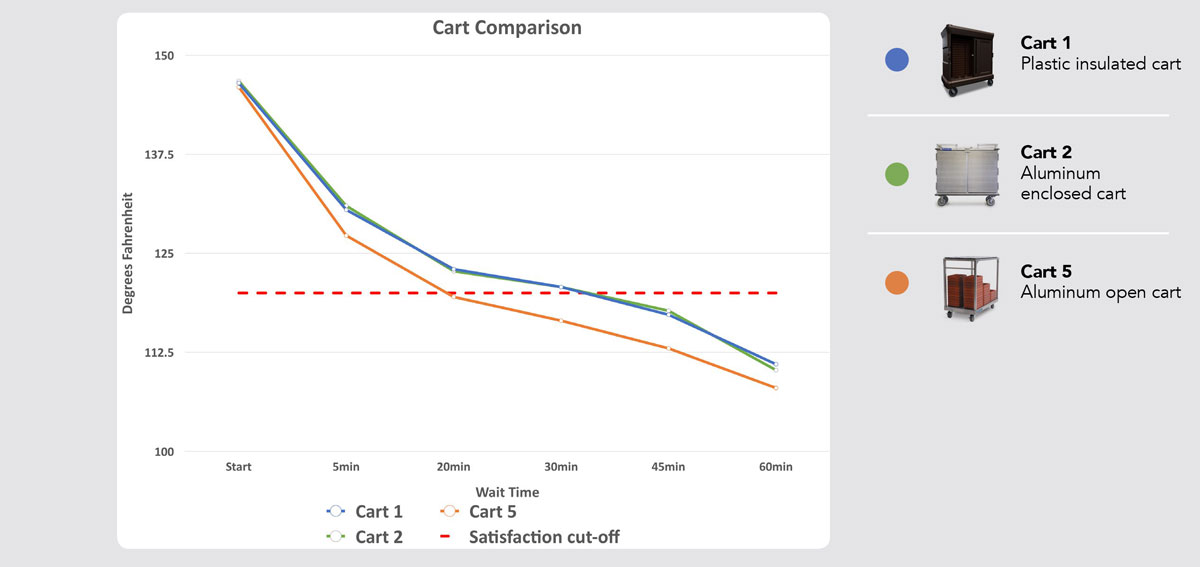
CONCLUSIONS
- The same phenomenon is true with the initial 5-minute temp loss explained in section 1 regardless of cart.
- The temperature retention performance of the plastic insulated cart and the enclosed aluminum cart was virtually the same and mirrors the results from section 2 with a different self-stacking solid plastic tray (A) (see blue and orange l ines in chart on page 4). Based on this result, you would not choose either of these carts to buy/use based on its ability to hold food temperatures. You would base your decision on other factors such as cost, durability, cleanability, ability to secure the food from tamper/theft, prevent contraband, ease of use, etc.
- With either of these two types of non-heated, enclosed carts, you need the ability to deliver and serve the meal within 20 to 30 minutes or it will likely be below the threshold for “hot food” when the first bite is taken.
- The open utility cart has a discernable poorer temperature retention with this other self-stacking tray (Solid plastic C). You would not be able to deliver and serve hot food in the housing unit in time with a non-insulated self-stacking tray and an open utility cart.
5. TRAY DENSITY IN A NON-HEATED CART
SUMMARY
THE FOOD WILL STAY HOTTER LONGER IN A NON-HEATED CART IF THE CART IS FILLED TO CAPACITY WITH TRAYS. IT WILL COOL FASTER IF YOU DELIVER A SMALL NUMBER OF TRAYS AT A TIME.
This trial is to test the hypothesis that you will improve temperature retention for a non-insulated solid plastic tray by increasing the number of trays placed in the enclosed cart. The idea is sort of like hot coals. If you pile a lot of hot coals together, they will stay hot longer than if you had a small pile of hot coals.
For all the tests in this trial, Tray A and the stainless-steel non-heated cart (Cart 3) were used.
Single stack trial Hot food items were portioned into the same two compartments for each tray and an initial temperature was recorded. The trays were stacked 7 trays high and placed in the cart and door shut. The 5 trays in the center of those 7 trays were used to take the temperature measurements.
Full cart trial The cart was completely filled with food trays. Very little open space remained inside the cart that wasn’t taken up by food trays. For expediency, hot food was only dished into the 9 trays at the center of each stack rather than the entire 18 trays in each stack. The 5 trays in the center of those 9 were used to take the temperature measurements.
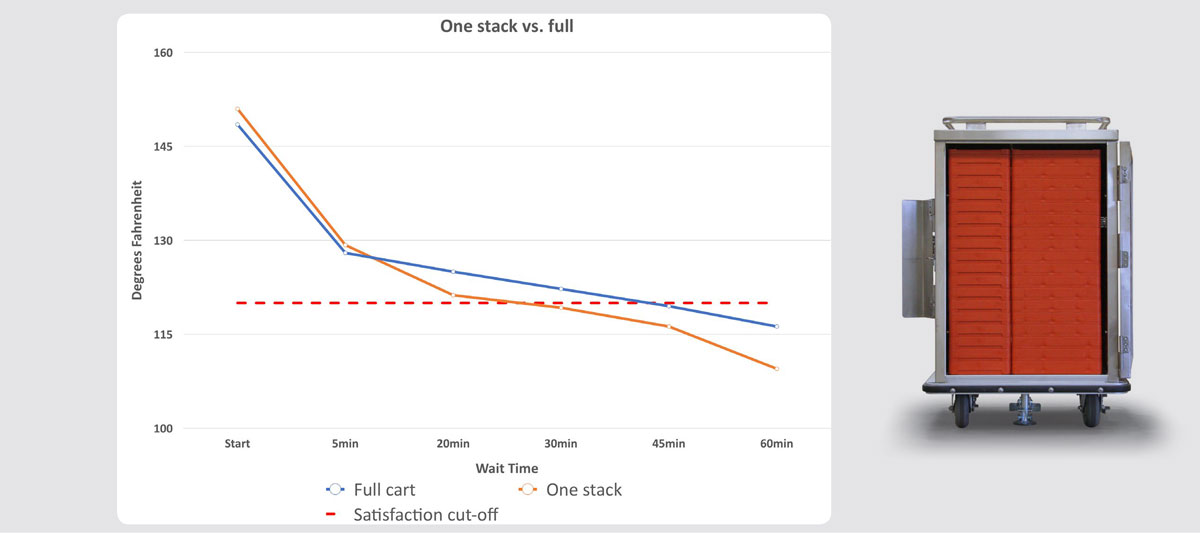
CONCLUSIONS
- Having the cart more densely packed with trays of hot food does, in fact, improve temperature retention. Conversely, if you deliver a small number of meals at a time, you can expect poorer temperature retention.
- The initial 5 minutes of temperature loss caused by the cooler temperature of the plastic tray surface does not change. It still pulls about 20°F out of the food temperature.
- The next 15 minutes is where the difference lies between a high concentration of meal trays in a cart verses a low concentration. With a low number of meals (one stack of 7), there is a lot of cooler ambient air in the cart that must normalize with the stack of hot food, thus cooling the food temperature. The loss between 5 min and 20 min is about 8°F (see orange line above).
- When the cart is full of trays of hot food, there is very little ambient temperature air for the hot food to normalize with so the temperature loss is simply linear after the first 5 minutes (see blue line above).
- The fuller cart has about 5°F less heat loss than the less full cart between minute 5 and minute 20. Practically speaking, to serve the meal at or above the 120°F threshold, you have about 40 minutes between tray up in the kitchen to first bite with a full cart rather than 20 to 30 minutes for just one stack.
SUMMARY CONCLUSION
We’ve talked about the reasons that food satisfaction is important in corrections. For those running correctional institutions or the food service operation within, it may not be the number 1 priority, but it definitely makes the list. There are many things that go into how satisfying a meal is, one of which is the temperature level where hot food is served. So, knowing how to ensure temperature retention for meals delivered to the housing units is good information to have. This study provides data-backed Information that can be used to make good decisions.
Based on sections 1-5 of this paper, here are the overall key takeaways from the study data.
- 1. If you are using solid plastic meal trays that do not have foam insulation and non-heated carts, you need to be able to deliver
the hot meals to the housing units in 20 to 30 minutes fr om tray up in the kitchen to first bite or up to 40 minutes for
completely full carts. Any longer than that will result in the hot food being 120°F or less, where hot food will typically
be unsatisfying. “My hot dogs are cold”.
- a. It doesn’t help temperature retention to use an insulated cart, whether plastic, aluminum or stainless steel. Any enclosed cart will perform about the same. Don’t pay more for a particular non-heated cart to help keep the food hot. It won’t.
- b. Using heated carts does help ensure that the hot food is being served hot. This is especially helpful in higher population facilities where meal delivery takes longer to complete. If you can’t always deliver the meal in less than 30 minutes, you need to use heated carts if you want to serve hot food.
- 2. If you are using foam insulated meal trays, you need to be able to deliver the hot meals to the housing units in 45 to 50 minutes
from tray up in the kitchen to first bite. Any longer than that will result in the hot food being 120°F or less. That temperature
will typically be unsatisfying. “My hot dogs are cold”.
- a. Any non-heated cart, including open utility carts, provide the same temperature retention when using insulated trays. Don’t pay more for a particular non-heated cart to help keep the food hot. It won’t.
- b. Using a heated cart with insulated trays is a ‘belt and suspenders’ approach. In the end, it will have a good result for food temperature even with long delivery times. The hot food will definitely stay hot and the cold food won’t get warmed up. There are more efficient ways to achieve this result such as a two tray system. (see #6 in [the article titled “THE 6 MAIN CORRECTIONAL MEAL DEIVERY SYSTEMS”] for more details)
-
3. Regardless of which tray and which cart you use to deliver meals to the housing units, there are some things that you can
do to help improve how hot the food is at point of service.
- a. Start with the highest possible starting temp. There are many steps in the food service process that allow the food to cool so starting high will help achieve a higher temp in the end.
- b. The biggest hit to temperature reduction is the hot food hitting the cooler tray surface. Approximately 20°F drop from this one step alone. Can you stage the trays somewhere in your kitchen to warm them slightly?
- c. Just like hot coals piled together, the fuller meal delivery cart will retain temperature better than one with few meals in it.
The 30 minute “cut-off” to serve hot meals with a non-heated cart can be a conflicting time point. “I can almost always make that but not 100% of the time”. “Am I close enough to that timing to get away with non-heated cart with no repercussions?”
It would be nice to try with lower cost non-heated carts and then switch to heated carts if something changes and it becomes a problem. But buying a full set of non-heated carts and then asking my boss for money later to replace them with heated carts is not a good career move. One solution would be to buy non-heated carts that have the ability to be converted to heated carts later by snapping in a removable heat box. If this sounds like it might be a good idea for your facility, google “Mission Ready Corrections Carts” or click [HERE].
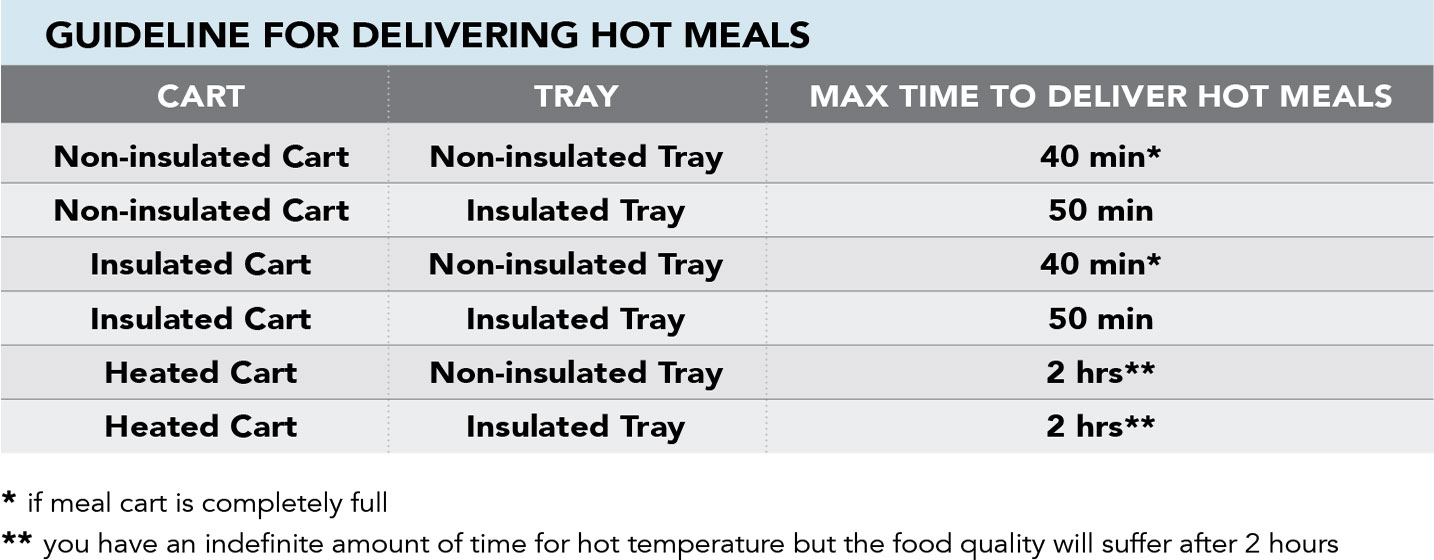
 Our Products Are Proudly Made In The USA
Our Products Are Proudly Made In The USA